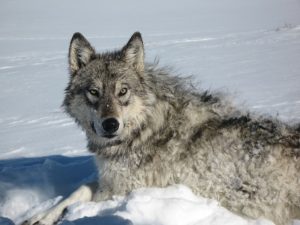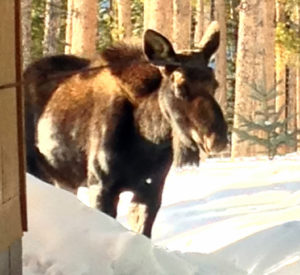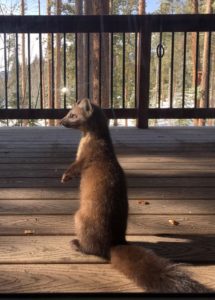
At one of the many silent auctions we hold in Grand Lake for worthy causes, my husband won a T-shirt. I’ve studied this shirt’s graphic a lot because it’s (1) beautiful and (2) ridiculously incorrect. The bottom portion of the graphic proudly proclaims “Colorado” and at the top is an imposing, snow-capped mountain. In the center are four animals: a bull elk (check), bull moose (check), grizzly bear (?) and howling wolf (?). Was the artist purposing messing with tourists, or did s/he not think it important to, maybe, spend three minutes doing research on this new fangled thing called the Internet? Although there are grizzlies in Wyoming, the last confirmed sighting in Colorado was in 1979. Although there are wolves in Wyoming (what do you say we avoid camping there?), in Colorado wolves are an extirpated species, meaning they no longer exist here but still exist in the wild elsewhere. Wolves were purposely eradicated from our state and last seen in the 1940s. But . . . (“Everybody I know has a big butt”—juvenile, but it’s one of my favorite Pee Wee Herman lines) since then there have been TWO confirmed wolves in Colorado.
The first was found dead from consuming poison in 2009 in Rio Blanco County, the northwest part of the state. And the second was found in (drumroll, please) our own Grand County; Kremmling, to be precise. A legal coyote hunter shot an animal near Wolford Mountain Reservoir on April 26, 2015, and after DNA testing, it was confirmed to be a gray wolf. BTW, the hunter was not charged since he obviously didn’t leap to the conclusion that he’d found a lone wolf that had traveled 1,000 miles from Montana’s Mill Creek pack.
So, will we soon be regularly hearing a wolf howl at the moon? Most gray wolves live in Michigan, Minnesota, Wisconsin (for the geographically challenged, not near us) and Montana, Idaho and Wyoming (all less than 1,000 miles away). And, true, males who have been kicked out of their pack are known to wander for thousands of miles. But given the number of highways and guns between here and there, no one believes a large number of packs will naturally populate Colorado anytime in the near future. Also, in January 2016 the Colorado Parks and Wildlife Commission voted NOT to allow the reintroduction of wolves back into the state, at least for now. Due to the wolf’s wandering nature, I’m sure the debate is not over between cattle and sheep ranchers vs. those who believe wolves will re-establish a sustainable population of moose, elk and deer.
For a fascinating and insightful read about wolf behavior, and a guy who may be a little “off,” try “The Man Who Lives with Wolves” by Shaun Ellis and Penny Junor. True story—unlike the design by that slipshod T-shirt artist.
This article was originally published in The Boardwalk newspaper, Grand Lake,
Colorado.

